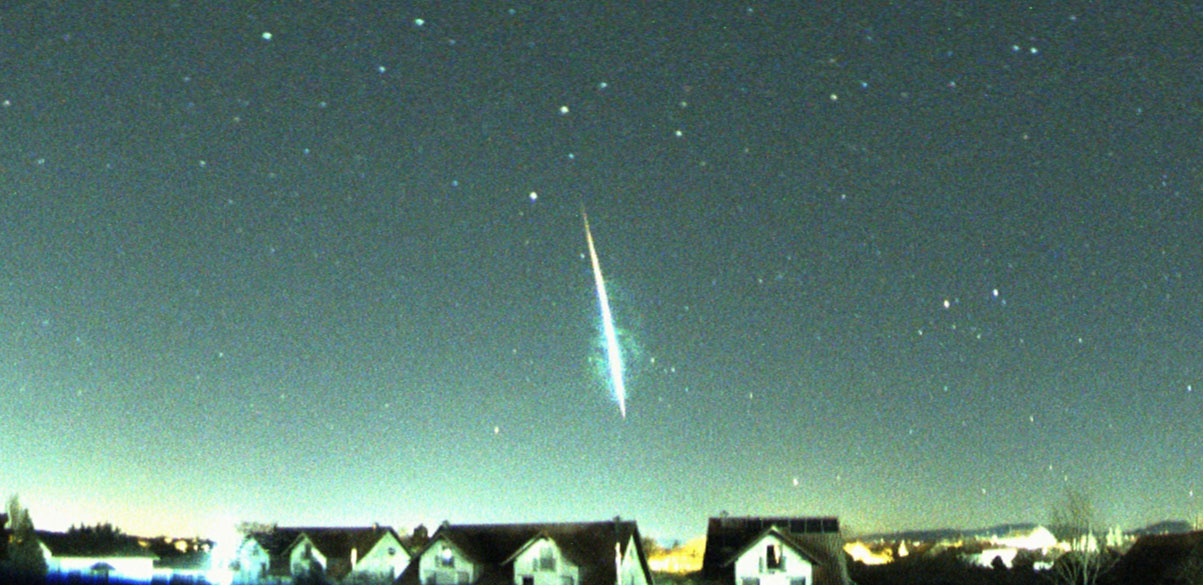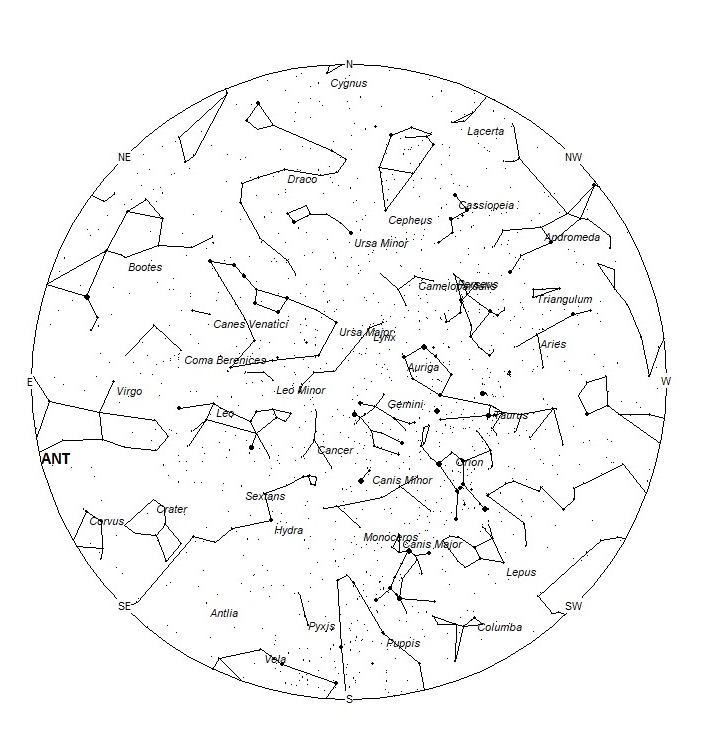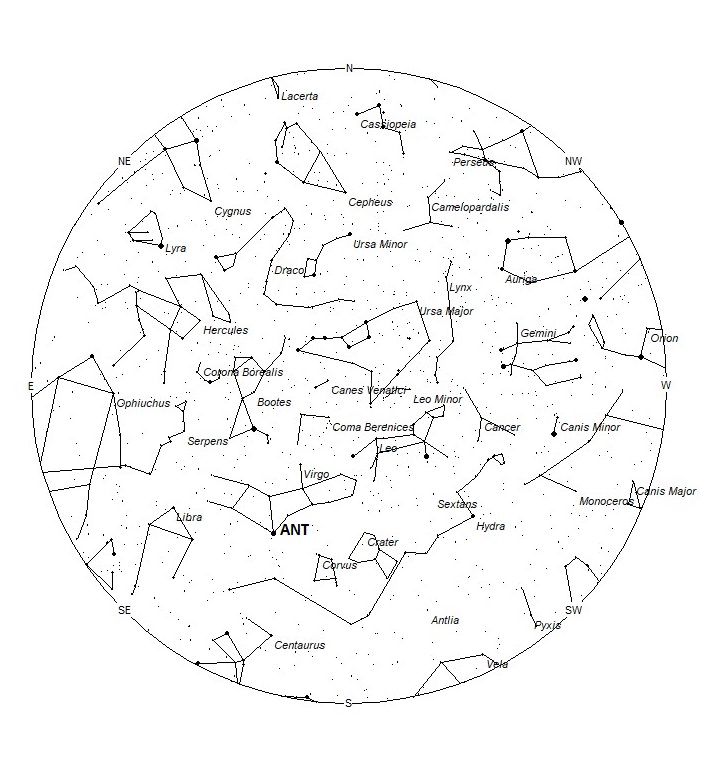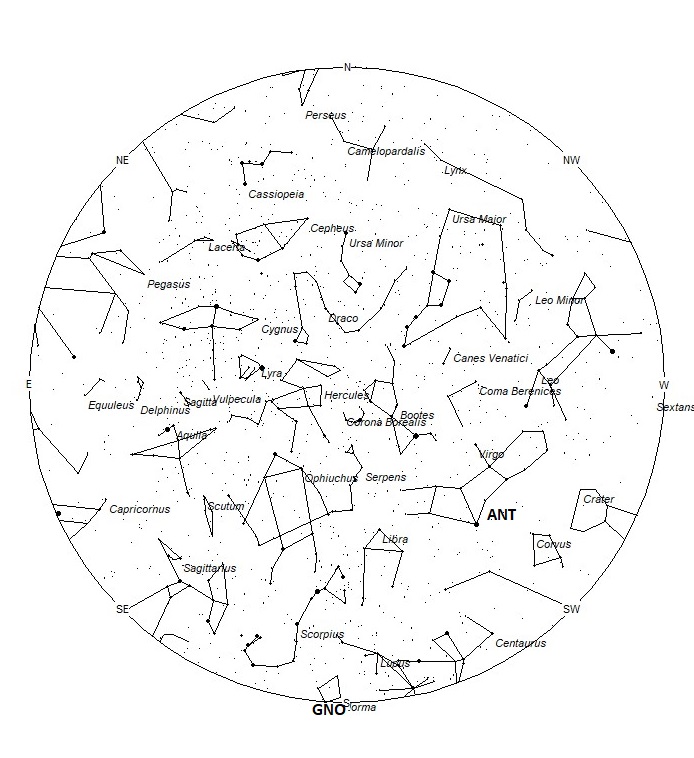 Mario Braun captured this bright fireball with a persistent train just above the horizon from Bornheim, Germany, on March 6, 2021, at 02:46 CET (1:46 UT). For more reports on this fireball, visit: https://fireball.amsmeteors.org/members/imo_view/event/2021/1341 Credit Mario Braun.
Mario Braun captured this bright fireball with a persistent train just above the horizon from Bornheim, Germany, on March 6, 2021, at 02:46 CET (1:46 UT). For more reports on this fireball, visit: https://fireball.amsmeteors.org/members/imo_view/event/2021/1341 Credit Mario Braun.During this period the moon reaches its first quarter phase on Sunday March 21st. On this date the moon is located 90 degrees east of the sun and sets near 02:00 local daylight saving time (LDST). As the week progresses the moon will interfere with the more active hours of the morning sky, especially toward dawn. The estimated total hourly meteor rates for evening observers this week is near 2 as seen from mid-northern latitudes and 4 as seen from tropical southern locations (25S). For morning observers, the estimated total hourly rates should be near 5 as seen from mid-northern latitudes (45N) and 11 as seen from tropical southern locations (25S). Evening rates are reduced due to moonlight during this period. The actual rates will also depend on factors such as personal light and motion perception, local weather conditions, alertness, and experience in watching meteor activity. Note that the hourly rates listed below are estimates as viewed from dark sky sites away from urban light sources. Observers viewing from urban areas will see less activity as only the brighter meteors will be visible from such locations.
The radiant (the area of the sky where meteors appear to shoot from) positions and rates listed below are exact for Saturday night/Sunday morning March 20/21. These positions do not change greatly day to day so the listed coordinates may be used during this entire period. Most star atlases (available at science stores and planetariums) will provide maps with grid lines of the celestial coordinates so that you may find out exactly where these positions are located in the sky. A planisphere or computer planetarium program is also useful in showing the sky at any time of night on any date of the year. Activity from each radiant is best seen when it is positioned highest in the sky, either due north or south along the meridian, depending on your latitude. It must be remembered that meteor activity is rarely seen at the radiant position. Rather they shoot outwards from the radiant, so it is best to center your field of view so that the radiant lies at the edge and not the center. Viewing there will allow you to easily trace the path of each meteor back to the radiant (if it is a shower member) or in another direction if it is sporadic. Meteor activity is not seen from radiants that are located far below the horizon. The positions below are listed in a west to east manner in order of right ascension (celestial longitude). The positions listed first are located further west therefore are accessible earlier in the night while those listed further down the list rise later in the night.
These sources of meteoric activity are expected to be active this week.
.
Reports from the Southern Hemisphere indicate that the obscure shower known as the delta Mensids (DME) are currently active from a radiant near 04:08 (062) -74. This position lies near the Mensa/Hydrus border, just east of the 3rd magnitude star known as gamma Hydri. These meteors are best seen just as soon as it becomes dark. Rates are normally very low but an outburst from this source was observed last year on March 20 and 22. With an entry velocity of 30km/sec., the average meteor from this source would be of medium-slow velocity. Due to the extreme southern location of this radiant, these meteors are nearly invisible from the Northern Hemisphere.
The center of the large Anthelion (ANT) radiant is currently located at 12:52 (193) -06. This position lies in central Virgo, 3 degrees southeast of the 4th magnitude star known as Zaniah. Due to the large size of this radiant, Anthelion activity may also appear from northern Corvus as well as Virgo. This radiant is best placed near 0200 LDST, when it lies on the meridian and is located highest in the sky. Rates at this time should be near 2 per hour no matter your location. With an entry velocity of 30 km/sec., the average Anthelion meteor would be of slow velocity.
The gamma Normids (GNO) are an ill-defined source, only well seen from the Southern Hemisphere. Some sources dispute its existence while others have differing activity periods in March. Here we list the parameters from an article on Meteor showers from the Southern Hemisphere by Sirko Molau and Steve Kerr*. Their results show the activity period is from March 22-27 with no distinct maximum. On March 24 the radiant is located at 16:24 (246) -51. This area of the sky lies in eastern Norma, 1 degree south of the 4th magnitude star known as Gamma2 Normae. These meteors are best seen during the last dark hour before dawn, when the radiant lies highest in a dark sky. With an entry velocity of 68km/sec., the average meteor from this source would be of fast velocity. Expected rates are less than 1 per hour. These meteors are poorly seen from the Northern Hemisphere.
The delta Pavonids (DPA) were discovered by Michael Buhagiar from Australia in the 1970’s. These meteors are active from March 11 through April 16, with maximum activity occurring on March 30th. The current position of the radiant lies near 19:28 (292) -61. This area of the sky lies in northern Pavo, 7 degrees southwest of the second magnitude star known as Peacock (alpha Pavonis). These meteors are best seen during the last dark hour prior to dawn. With an entry velocity of 58km/sec., the average meteor from this source would be of fast velocity. Expected rates are less than 1 per hour during this period. Like the gamma Normids, these meteors are poorly seen from the Northern Hemisphere.
As seen from the mid-northern hemisphere (45N) one would expect to see approximately 5 sporadic meteors per hour during the last hour before dawn as seen from rural observing sites. Evening rates would be near 1 per hour. As seen from the tropical southern latitudes (25S), morning rates would be near 8 per hour as seen from rural observing sites and 3 per hour during the evening hours. Locations between these two extremes would see activity between the listed figures. Evening rates are reduced during this period due to moonlight.
*WGN 42-2, Meteor showers of the southern hemisphere, page 25
The list below offers the information from above in tabular form. Rates and positions are exact for Saturday night/Sunday morning except where noted in the shower descriptions.
| SHOWER | DATE OF MAXIMUM ACTIVITY | CELESTIAL POSITION | ENTRY VELOCITY | CULMINATION | HOURLY RATE | CLASS |
| RA (RA in Deg.) DEC | Km/Sec | Local Daylight Saving Time | North-South | |||
| delta Mensids (DME) | Mar 12 | 04:08 (062) -74 | 30 | 17:00 | <1 – <1 | III |
| Anthelion (ANT) | – | 12:52 (193) -06 | 30 | 02:00 | 2 – 2 | II |
| gamma Normids (GNO) | Mar 24 | 16:24 (246) -51 | 68 | 06:00 | <1 – 1 | IV |
| delta Pavonids (DPA) | Mar 30 | 19:28 (292) -61 | 58 | 09:00 | <1 – <1 | IV |
 American Meteor Society
American Meteor Society



Just saw a blue green slow bright shooting star…fireball in mount Vernon in Alexandria Virginia (22309 ) at about 12:30 am on 3/21/21 the day after the first day of spring.
Very cool
I saw it too! Pretty cool!
Me three, in wester PA
We saw one too in NJ while driving on 78 west near Summit at 12:23 am.
I captured this one on my nest cam. Perfect shot!
OMG, i have been searching for others who saw this and maybe captured it! Anyway you could share what you caught with me??
I believe this is the one I saw, as well, but I thought it was headed toward Rockville. 🙂 Would love to see one like this again in my lifetime. I have my doubts it will happen, though.
On our drive home, husband and I just saw one tonight!(3/25/21)
Saw what appeared to be either a crash of a plane or a very visible and close meteor…. Green with fireball behind it… over the Massachusetts/Connecticut border near Sturbridge. What was it?
This was a fireball, which is a meteor that is larger and brighter than normal.
Thanks!
We are currently staying at a cabin in Marrienville, PA. At approximately 1:30, there was a very bright flash that lit up the sky! It was orange, then white like lightning. Was this a fireball?
We have received many reports from your area of a fireball occurring at 12:24am EDT on March 21st. This was most likely what caused the flash you witnessed.
Saw 2 almost simultaneously at about 12:25am today, March 21,2021 in Hunterdon County, New Jersey. First was closer on angles downward trajectory and bright green shape looked almost like a half moon. As I stared trying to understand what I just saw, another shot downward further in distance, this one was white. No noice, flashes. It was extremely clear last night and moon visible even during the day. Something amazing to have seen, no doubt.
At 12:35 am today March 21,2021 I saw a huge bright green light pass over the southern skyline ! It was a giant circle that I was shocked to see which initially looked like a firework display in the sky when it burst then it descended downwards. The tail end of it was orange in color. I live in upstate NY in Seneca Falls, NY. Amazingly beautiful!!
Saw a green “star” traveling down with fireball behind it. The entire sky flashed.. this was March 21st at around 12:00 AM in the Bethlehem, PA area. My boyfriend was in Scranton, PA (about an hour and a half away) and saw it too!
Meteor sighting over NE LA on 3/20/21 at about 6 pm or so. It was a fairly bright streak actually over the Mt. Wilson Observatory.
Actually the timing was actually close to 7:45 PM. J-Ko
3/20/21. Lecanto, Florida. Meteor traveling East to West. Very close to ground. Very bright white with long tail. Burned out as it went below true level. Absolutely amazing sight.
Saw a low flying meteorite over Minnesota Twins ballpark near Ft. Myers, FL last night 3/20/21 between 8-9pm. Bright red with a sputtering trail, kinda like a huge bottle rocket! Very cool.
March 21, 2021, around 12:30am, I was talking to my Mom, and shouted, “I just saw a plane crash!” I looked up what meteors look like, and realized, it was a meteor, thankfully. Coming in, really fast, in Berks County, PA.
At March 22nd 2021, at approximately 10:38pm, I saw a meteor or maybe a comet that lasted like 4 seconds. That’s pretty long actually. It flew across the whole sky. Tell me if anyone else saw this
that could have been the ISS but this morning at about maybe 7:05 I saw a big red/orange mark across the sky then a little ball it was magnificent!
Just stumbled onto this website. I love looking at night sky but seem to miss meteor showers. Thank you for the monthly schedule but how can an amateur/newbie find where you would be able to see these events?
I live close to Dallas Texas and would love to see something before I leave this earth.
Thank you.
Elaine and All,
It is a common notion that meteor showers can only be seen from certain locations. This is only true if you are located at extreme northern or southern positions where the sun is above the horizon 24 hours a day or the source of the meteors never rises above the horizon. For major cities like Dallas, observers located there can see all of the major annual showers on the listed nights of activity. Most of these showers are best seen during the early morning hours when the source of the meteors is located high in the sky. Meteor showers are caused by the Earth passing through trails of small particles that were blown off of comets as they pass near the sun. Most of these particles are actually dust and are too faint to be seen as meteors to the naked eye. Radar and specialized telescopes can detect these faint meteors. The meteors we see with the naked eye are particles at least a millimeter in size and are spaced very far apart in these trails of material. Even during the strongest meteor storms, these larger particles have been estimated to be separated by at least 15 miles from each other. It is the Earth’s fast velocity through space that makes these meteors appear every few seconds during these meteor storms. Unfortunately meteor storms are rare and the actual spacing between particles is much larger during a strong meteor shower that produces an average of one meteor per minute. So to see these meteors one needs to find a location that is as dark as possible. If you cannot see many stars from home, you will not see many meteors either. Local astronomy clubs usually offer safe locations outside the glare from cities where you can see better see meteor activity. You will be surprised just how much difference a dark sky makes!
Not all meteors are millimeter size and smaller. There are larger particles orbiting the sun that encounter the Earth as fireballs. These fireballs are meteors that are brighter than anything in the sky except the sun and moon. It only take a particle the size of a softball to produce the light of a full moon for an instant before dissipating. These large particles are rare, but best seen during the major annual meteor showers.
So the key to viewing meteor showers is to view on a night that is close to the date of maximum activity. And then view from a location that is as dark as possible. Read articles on upcoming meteor showers that offer other viewing hints such as avoiding moonlight which can obscure fainter meteors as much as city lights.
On 3/23/2021 at approximately 3:45 PM 30 miles outside of Roswell, NM on highway 70 I saw a comet or meteor moving south really fast. At first thought it was a plane but it was moving fast and falling with a tail of white behind it.
Saw this too in peninsula VA around early 5am. Looked like a blue white streak took a swandive out the sky.